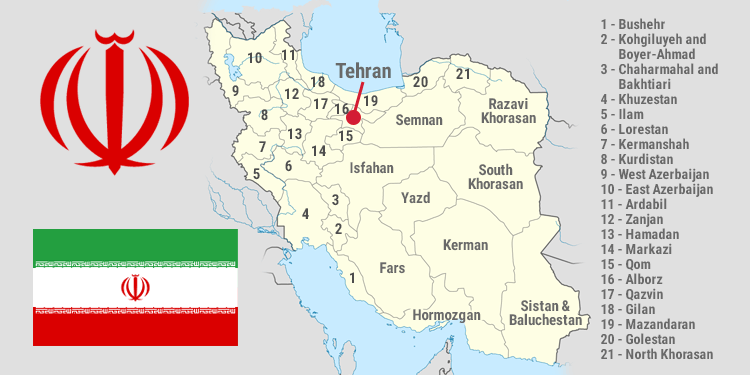Iran overview

Formal name: Islamic Republic of Iran
Location of Iran: Iran is situated in Western Central Asia in the area commonly referred to as the Middle East. It was geographically known as Persia until as recently as the twentieth century. In the North and Northwest, it is bordered by the Caspian Sea, Azerbaijan (not to be confused with its own Iranian Azerbaijan region), Armenia and the autonomous Nakhchivan enclave. To the West lie Turkey and Iraq. Its southern boundaries extend to the scenic shores of the Persian Gulf and Gulf of Oman. It is adjacent to Afghanistan and Pakistan in the East and Turkmenistan to the Northeast.
Capital: Tehran (located in its titular province).
Area: Total 1,648,195 km2: land 99.3%, water 0.7%.
Land boundaries: Total 5894 km.
Border countries: Turkmenistan 1,148 km (713 mi), Turkey 534 km (332 mi), Iraq 1,599 km (994 mi), Armenia 44 km (27 mi), Azerbaijan Nakhchivan Enclave 44 km (27 mi), Azerbaijan 432 km (268 mi), Afghanistan 921 km (572 mi), Pakistan 959 km (596 mi).
Population: Total: 80 million (2017 est.).
Tehran: 8.5 million (proper), 15 million (metro),
Isfahan: 2 million (proper), 4.8 (metro),
Mashhad: 2.7 million,
Karaj: 2 million,
Tabriz: 1.5 million,
Shiraz: 1.5 million (proper), 1.8 (Shiraz County).
Language: Linguistically diverse, Persian (Farsi) is spoken by the majority of Iranians. Several other related Indo-Iranian languages belonging to the Indo-European language family are spoken - Kurdish, Gilaki, Mazandarani, et al. Sizeable minority languages include Armenian, Azeri Turkish, Caucasian languages such as Georgian and Circadian, and Arabic, among others.
A large percentage of millennial Iranians speak moderate to advanced English. Tourist information is available in English at many hotels and cultural attractions. As expected, signs, services and general information in rural and remote areas are less likely to accommodate the Anglophone tourist than in more populated areas.
The Perso-Arabic alphabet is the national standard. However, some signs, menus and general information are posted in English.
Administrative and territorial structure: 31 Provinces, 324 counties (shahrestans), 89 cities.
Religion: Islam is the national religion. Zoroastrianism remains active in small pockets throughout the country.
Currency: The official currency of Iran is the Iranian rial. Super-units of 10,000 (toman) are divisible into subunits of dinar.
USD, Euros, GBP and other currencies can be exchanged for rial throughout Iran.
According to the IATA, any amount exceeding 10,000 USD must be declared upon arrival as is standard when entering most countries.
Day to day expenses such as dining and transportation are surprisingly affordable compared to Western economies. Accommodation rates may vary according to location, amenities and level of service provided.
National symbols: Flag of Islamic Republic of Iran. The National Emblem features a unicon comprising a sword and stylized symbol for “ala”, collectively representative of a tulip.
Climate: The climate of Iran is as diverse as its topography ranging from mild and wet subtropical rainforest on the Caspian coast at Golan to the Mediterranean climate of Shiraz; very cold mountains of the Zagros and Alborz to the hot dry deserts of Lut and Kavir Buzurg; semi-desert of Tehran to dry coastal climate on the Persian Gulf and Gulf of Oman coasts.
Summers in the North are usually temperate with high temperatures averaging about 27 oC. Winters are generally mild in the South with average low temperatures around 13 oC. Summers are hot and sometimes humid, pending on the region.
Iran’s diverse climate allows for an amazing array of leisure and adventure activities. Skiing and extreme snow sports, scuba diving and snorkeling, ecotourism and safari are all within a short distance of each other almost year round.
